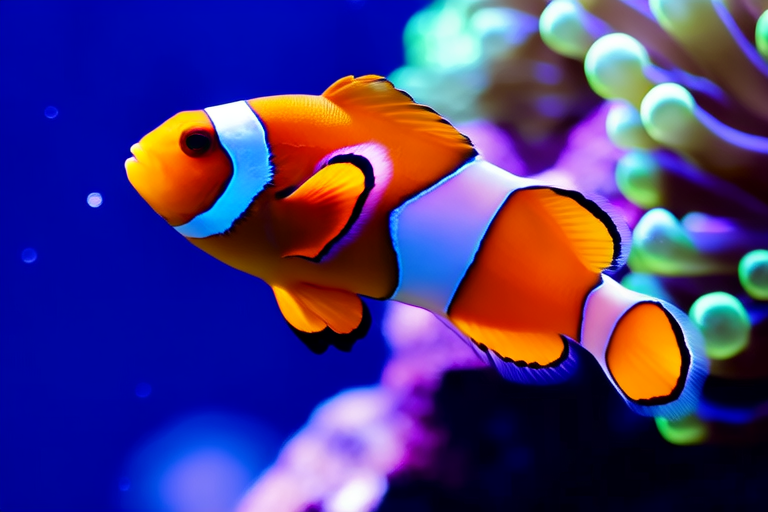From Finding Nemo to Your Tank: How to Care for a Pet Clownfish
The charismatic and vibrant clownfish, popularized by the animated film “Finding Nemo,” has captured the hearts of millions worldwide. This movie not only entertained audiences but also sparked a significant interest in marine life, particularly among aquarium enthusiasts. The clownfish’s striking appearance and seemingly endearing nature have made it one of the most sought-after fish for home aquariums. However, caring for a pet clownfish requires more than just a tank and some water. This comprehensive guide will walk you through everything you need to know to provide your clownfish with a healthy and thriving environment.
Natural Habitat and Behavior
Clownfish, scientifically known as Amphiprioninae, are native to the warm waters of the Pacific and Indian Oceans. They are commonly found in coral reefs, where they establish symbiotic relationships with certain sea anemones. These anemones provide protection from predators, while the clownfish, in turn, bring nutrients to the anemone through their waste. Clownfish are omnivorous, eating algae, zooplankton, and small crustaceans. Their behavior is fascinating; they exhibit a unique social structure within their groups, with a dominant female leading a harem of males. Understanding these aspects of their natural habitat and behavior is crucial for creating an enriching environment in your aquarium.
Setting Up the Tank Environment
Tank Size
To ensure your clownfish thrives, start by choosing an appropriately sized tank. A minimum tank size of 20 gallons is recommended for a single clownfish. However, if you plan to keep multiple clownfish or add other species, a larger tank is preferable. A 40-gallon tank is ideal for a small group of clownfish, providing ample space for swimming and exploration.
Water Conditions
Maintaining proper water conditions is essential for the health of your clownfish. The water temperature should be kept between 76°F and 82°F (24°C to 28°C). The pH level should range from 8.1 to 8.4, and the specific gravity should be maintained at 1.020 to 1.025. Regular testing and monitoring of these parameters are vital. Additionally, a stable salinity level is crucial, so invest in a quality hydrometer to measure salt concentration accurately.
Necessary Equipment
Your aquarium setup should include a high-quality filter that promotes water circulation and maintains water clarity. An efficient protein skimmer is also beneficial for removing organic waste. A heater with a thermostat is necessary to maintain consistent water temperature. A reliable thermometer can help monitor temperature fluctuations. Lastly, consider adding a UV sterilizer to prevent the growth of harmful bacteria and parasites.
Diet and Feeding Requirements
Clownfish are omnivorous and require a balanced diet to stay healthy. In the wild, their diet consists of algae, zooplankton, and small crustaceans. In captivity, you can feed them a variety of commercial foods, including flake food, pellets, and frozen or live foods such as brine shrimp, mysis shrimp, and bloodworms. Feed your clownfish twice daily, offering amounts they can consume within a few minutes. Overfeeding can lead to poor water quality and health issues.
Selecting Compatible Tank Mates
When selecting tank mates for your clownfish, it’s important to choose species that share similar water conditions and temperament. Clownfish are generally peaceful, but they can become territorial when space is limited. Suitable tank mates include small, non-aggressive fish like cardinal tetras, guppies, and other clownfish species. Avoid keeping them with aggressive or large fish that may bully or eat smaller fish. Additionally, ensure that any invertebrates added to the tank are safe for clownfish to coexist with.
Common Health Issues and Preventive Measures
Like all aquatic animals, clownfish can face various health issues. Common problems include fin rot, ich, and bacterial infections. Fin rot is often caused by poor water quality and manifests as frayed or disintegrating fins. Ich, a parasitic infection, appears as white spots on the fish’s body. Bacterial infections can result from stress or injury and may cause lethargy, loss of appetite, and ulcers. To prevent these issues, maintain optimal water conditions, perform regular water changes, and quarantine new additions to the tank before introducing them.
Ongoing Care and Enrichment Activities
Providing ongoing care and enrichment activities is key to ensuring the longevity and happiness of your clownfish. Regular water maintenance is crucial; perform weekly water changes of 10-15% to keep the tank clean and healthy. Monitor water parameters closely and address any deviations promptly. Additionally, offer mental stimulation through enrichment activities. Introduce novel objects like PVC pipes or artificial plants to encourage exploration and mimic their natural environment. Regularly observe your clownfish for any signs of stress or illness, and adjust their care routine accordingly.
In conclusion, caring for a pet clownfish involves more than just providing a tank and water. By understanding their natural habitat, setting up an appropriate tank environment, and ensuring a balanced diet and compatible tank mates, you can create a thriving and happy home for your clownfish. With proper care and attention, your pet clownfish can bring years of joy and fascination to your aquarium. Embrace the responsibility and enjoy the rewarding experience of owning these captivating creatures.
